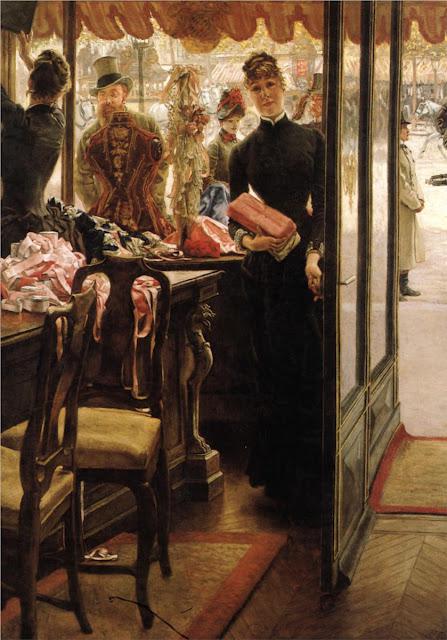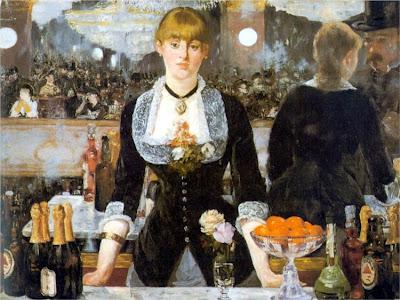 An intimate warmth predominates
James Tissot’s The Shop Girl
(1883-1885). The shaded interiormakes
the viewer feel like an elite insider. The black-clad girl opening the shop’s
door onto a lively Paris
street is the focus of the work. Inside, a hushed serenity is achieved through
the muted light and the gentle shadows on the girl’s face. The world outside
the shop is hustling and bustling and is depicted as such through Tissot’s slapdash brush
strokes, whereas his work on the young lady is barely decipherable.
An intimate warmth predominates
James Tissot’s The Shop Girl
(1883-1885). The shaded interiormakes
the viewer feel like an elite insider. The black-clad girl opening the shop’s
door onto a lively Paris
street is the focus of the work. Inside, a hushed serenity is achieved through
the muted light and the gentle shadows on the girl’s face. The world outside
the shop is hustling and bustling and is depicted as such through Tissot’s slapdash brush
strokes, whereas his work on the young lady is barely decipherable.
The viewer’s eye first alights to the central shop girl and the pink package she holds and is then drawn to the recurring black figure on the left. This repetitive design element bounces us back from the edge of the frame to the busyness in the window and the pile of ribbon on the counter. The open door seems less important than what has just transpired in the shop.
This nineteenth century slice of life is as accurately detailed as a photograph. However, Tissot used a palette of oil paints to subtly blend colours necessary for warm skin and ribbons. Slow-drying oil paint was a necessity for Tissot, who took two years to complete this work. Unlike a photo, the painting is large, about 1x1.5 metres. From the perspective of a gallery goer standing about a meter away, Tissot’s shop girl seems almost life-sized.
Tissot places the viewer into the shoes of a male who has just purchased something for a woman. Men are gazing at the shop girls through the window, as if they too were commodities or confections. A woman from a higher place in society passes with her eyes demurely averted. There is a lot of masculine attention going on. The central girl has met the male gaze of the viewer and is intensely maintaining it. She’s about to hand the gentleman shopper his package as he joins his chauffeur and horses outside.
The somberly-clad shop girl contrasts with the tumble of pink ribbons on the countertop revealing, perhaps, that the high-buttoned girl could just as easily become “undone” as the pink mess left on the counter. Tissot’s painting contains other elements that could allude to hidden pleasures: the cupped “V” of the rosy package pointing to the girl’s lap where there lays a barely decipherable pocket; the wooden gargoyle lasciviously pointing his tongue; and the ribbon artfully fallen into a heart shape on the floor.
To me, The Shop Girl is reminiscent of Manet’s A Bar at the Folies Bergere (1882). In both, a black clad server with something to offer locks eyes with the viewer. Each contains a disconcerting back view of another in black: in Tissot’s, an identically-dressed assistant; in Manet’s, a skewed reflection. These strange dopplegangers may be alluding to the fact that even though these working girls give the illusion that they are of the same class as the men they are serving, in reality, they are removed from it. Here the similarity with Manet’s Impressionistic style ends as Tissot’s small, mannered brush strokes realistically portray the shop girl’s face and the shop’s interior. Although completed at the height of Impressionism, Tissot’s work does not reflect the style of the day.

Copyright Hazel Smith, 2011 Proviso -FAH 245 should probably not copy this.

